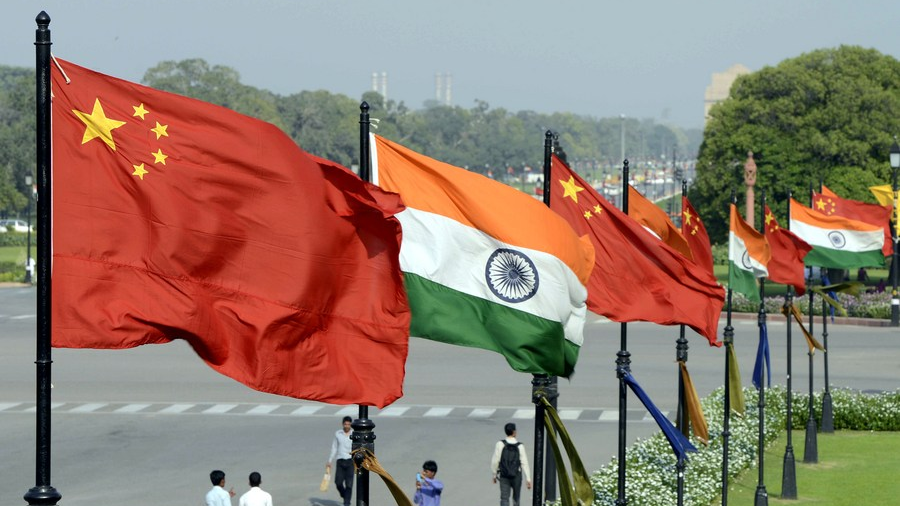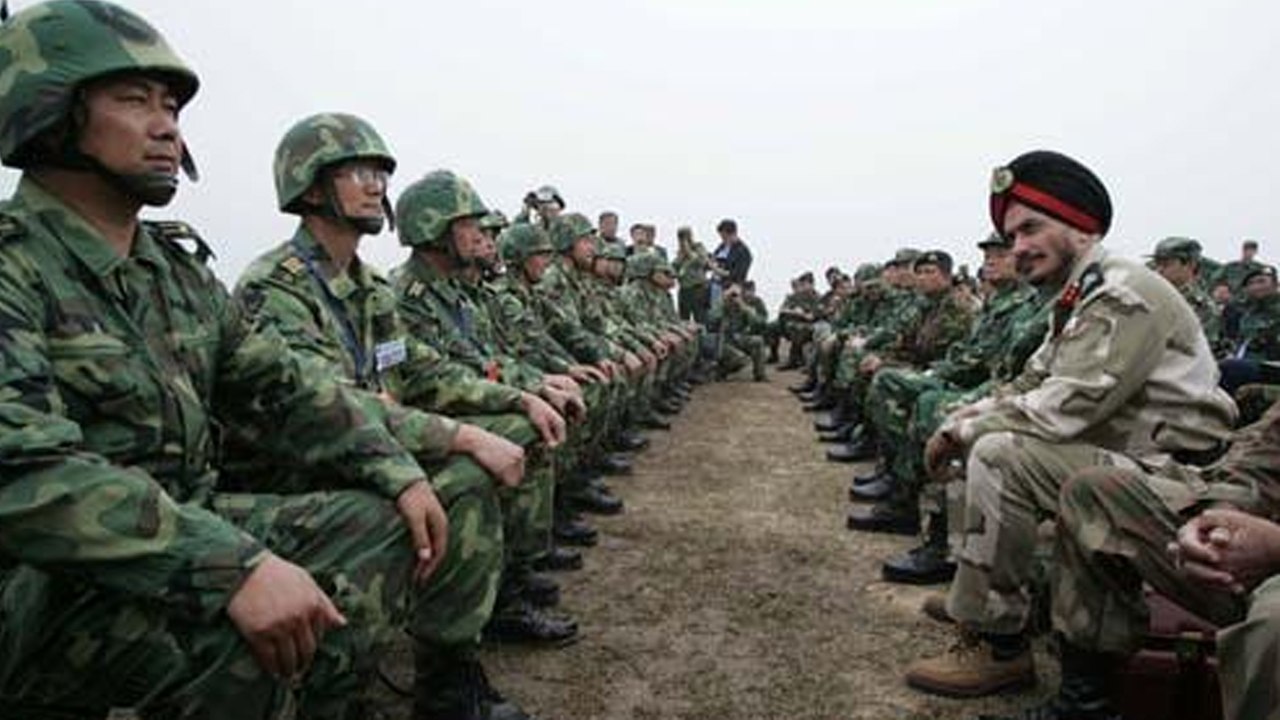
Indian and Chinese national flags flutter side by side on lamp posts at the Raisina Hills in New Delhi, September 16, 2014. /Xinhua
Indian and Chinese national flags flutter side by side on lamp posts at the Raisina Hills in New Delhi, September 16, 2014. /Xinhua
Editor's note: Rabi Sankar Bosu is an Indian contributor to Chinese media outlets. He writes about Chinese politics, social and cultural issues, and China-India relations with a special interest in the Belt and Road Initiative. The article reflects the author's views, and not necessarily those of CGTN.
With the beginning of 2022, the China-India Corps Commander Level Meeting entered the 14th round on January 12, which was held on the Chinese side of the Line of Actual Control (LAC), following up on the 23rd meeting of the Working Mechanism for Consultation and Coordination on India-China Border Affairs on November 18, 2021. The 14th round meeting of the Senior Commanders of both sides was an effort to resolve the unsettled disengagement process along the western sector of the India-China border following counter-accusations of trespass since April 2020.
According to media sources, it is learnt that during the 13-hour meeting between top commanders of the Chinese and Indian armies, the Indian side represented by the new 14 Corps chief Lt Gen Anindya Sengupta focused on the disengagement process in all the remaining friction points in Patrolling Point 15 in the Hot Spring area including resolution of issues in Depsang Bulge and Demchok in eastern Ladakh.
Unlike the 13th round of India-China military talks, which saw the disengagement issue ended in an impasse with the issuance of two separate accusatory statements, the 14th round saw a tepid joint statement on January 13, bringing some relief to the 19-month-long border row that has fractured China-India relations in recent years. The bright part of the joint statement is that "The two sides had a frank and in-depth exchange of views for the resolution of the relevant issues along the LAC in the Western Sector."
The joint readout clearly articulated that taking the guidance provided by the state leaders, both sides "agreed to consolidate on the previous outcomes and take effective efforts to maintain the security and stability on the ground in the Western Sector including during winter." Although the latest military talks fails to achieve any major breakthrough in the vexed border issue between the two Asian giants, encouragingly both sides underline that a continuing dialogue via military and diplomatic channels will properly deal with the protracted border skirmishes and stand-offs. Surely this will enable progress in bilateral relations.
In order to maintain peace along the LAC, both sides should not seek any unilateral superiority over each other. Both sides must respect boundary treaties and agreements already in place between the Chinese and Indian governments. But unfortunately, the Indian pro-nationalist government under Prime Minister Narendra Modi has openly supported the U.S. Indo-Pacific Strategy and thus tried to project China as an expansionist country with a willful misrepresentation of the boundary dispute.
It's unfortunate that just prior to the 14th meeting between the two countries' armies, Indian Army Chief General Manoj Mukund Naravane made a high-pitched egoistic remark about the possibility of war due to China's military deployment along the western section of the Ladakh border. "India will deal with the People's Liberation Army (PLA) in a firm and peaceful way, but if it comes to war or conflict, the country will emerge victorious," he said. Undoubtedly, such rhetoric is certainly not conducive to easing India-China border tensions.
Justifying its military deployment and construction activities on Chinese territory, China's Foreign Ministry Spokesperson Wang Wenbin on January 13 criticized the Indian Army Chief General's remark by stating that the two countries are "in dialogue and communication through diplomatic and military channels to ease the situation at the border" and "we hope that certain individual on the Indian side would refrain from making [sic] unconstructive remarks."

A commander-level meeting between China's Southern Xinjiang Military District chief and India's 14 Corps commander is held on the Chinese side of the Line of Actual Control at the China-India border, June 6, 2020. /Xinhua
A commander-level meeting between China's Southern Xinjiang Military District chief and India's 14 Corps commander is held on the Chinese side of the Line of Actual Control at the China-India border, June 6, 2020. /Xinhua
It should be noted here that the 3,488 kilometer length of the LAC along the India-China border has long remained a sore spot between the two nations due to their perceptional differences of where the border lies. As in the words of Alyssa Ayres, a South Asia expert at the Council on Foreign Relations, "China and India have differing ideas of where it should be located, leading to regular border transgressions."
Since there is no agreement of a common border currently recognized by the both sides, a worrisome atmosphere prevails on the China-India border following accusations of incursions by both Chinese and Indian front-line soldiers. The tangled territorial dispute resulted in the 1962 Sino-Indian War, and the 1975 violent India-China face-off at Tulung La in Arunchal Pradesh, in which four Indian soldiers lost their lives.
Although the Sikkim section of the China-India border is well-defined by treaties, on June 18, 2017, over 270 Indian border guards had trespassed into China-controled territory near Dong Lang area in southern Tibet Autonomous Region, over which China has "indisputable sovereignty" according to the Convention between Great Britain and China Relating to Sikkim and Tibet (1890). The 73-day military stand-off was eventually resolved through a mutual disengagement on August 28, 2017.
But the Galwan Valley clash of June 15, 2020 between Indian and Chinese forces is more serious than the Dong Lang military standoff as it left 20 Indian and five Chinese frontier officers and soldiers dead. Undoubtedly, the June 15 Ladakh fighting took Sino-India ties in a different direction as in the words of India's External Affairs Minister S Jaishankar. He reiterated India's view that the advancement of ties was "predicated on ensuring that peace and tranquility was not disturbed, and the Line of Actual Control was both observed and respected by both sides."
Simultaneously, China calls for unlinking the boundary dispute from the overall bilateral relations. As Chinese State Councilor and Foreign Minister Wang Yi noted, "The boundary dispute, an issue left from history, is not the whole story of the China-India relationship." It is hoped that the general picture of Sino-India friendship will not stagnate due to the difficulty of one issue or incident at one time.
Since the several rounds of military talks and a series of diplomatic confab between China and India so far have not yielded full disengagement and de-escalation, it can be hoped that a top-level political meeting between President Xi Jinping and Prime Minister Modi can be conducive to achieve disengagement in areas where there is conflict at present.
Talks are seen as the only way forward. Reasonable choices have to be made by both countries and there is definitely a need to focus on the "big picture" of bilateral relations. Both countries have as much to lose in a military conflict. The onus lies on both leaders of China and India to seek an early settlement of the protracted boundary dispute, to remove misreading of each other's strategic intentions, to envisage each other's core interests to take forward vibrant trade links, which is most indispensable for substantiating the Sino-Indian partnership at large.
(If you want to contribute and have specific expertise, please contact us at opinions@cgtn.com.)

